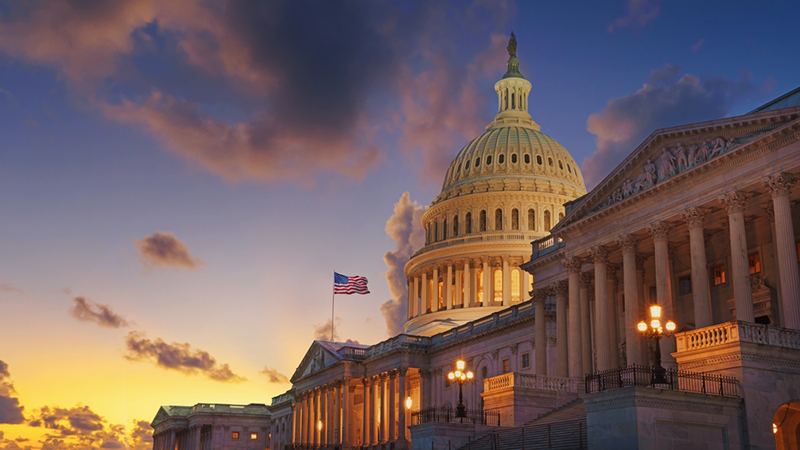U.S. – Netherlands Income Tax Treaty
The United States and the Netherlands share a robust economic relationship, facilitated in part by a comprehensive tax treaty designed to prevent...
10 min read
 H&CO
Aug 14, 2025 4:43:50 PM
H&CO
Aug 14, 2025 4:43:50 PM

What is the One Big Beautiful Bill Act? The OBBBA is a broad tax and spending package enacted on July 4, 2025. It combines individual tax relief (including several targeted deductions/exclusions), business and international tax changes, and non-tax items. As with prior omnibus tax laws, it mixes temporary, permanent, and phased provisions.
The federal government played a central role in passing and implementing the OBBBA, including allocating funds and expanding agencies to support the new policies. The OBBBA is also positioned as a jobs act, encompassing employment, tax, and benefit reforms that impact both employers and employees.
A formal bill text exists as H.R. 1 (119th Congress), with section-by-section materials circulating from committee sources; practitioner summaries and IRS pages have begun detailing specific mechanics, effective dates, and implementation notes. Expect further IRS guidance and forms instructions as the 2025 filing season nears and as 2026 withholding changes are staged in.
The act has significant implications for federal spending, affecting government expenditures, entitlement programs, and broader fiscal priorities.
>> FAQs about OBBA
What: Additional $6,000 deduction for taxpayers age 65+ (per eligible individual) for 2025–2028, as an additional deduction supplementing the base deduction. This extra tax benefit provides greater tax savings for eligible expenses, especially for those who itemize, and is in addition to the existing senior additional standard deduction.
Phase-out: Begins over $75,000 MAGI (single) / $150,000 (MFJ).
Who benefits: Retirees and older workers above the standard deduction but below the phase-out ranges.
New eliminations/exclusions for tax on tips and overtime. The OBBBA introduces new reporting requirements for qualified overtime pay and qualified tips, which must be separately reported on Form W-2. Employers will need implementation guidance for W-2 reporting/withholding and coordination with FICA rules; the IRS has already signaled that much of the withholding infrastructure will stay as-is for 2025, with broader changes integrated in 2026. Qualified overtime pay and qualified tips may be eligible for specific tax deductions for employees. Updated overtime pay regulations under the Fair Labor Standards Act may impact eligibility for these deductions. Employees may still see 2025 benefits via return-level adjustments.
What: A new tax deduction for car loan interest on new vehicles purchased beginning in 2025 (with income limits; lease and used-car buyers typically excluded). To qualify, the vehicle must have undergone final assembly in the United States. Taxpayers must include the vehicle identification number (VIN) on their tax return when claiming this deduction.
Duration: Current reports suggest through 2028.
Offset interaction: Some coverage notes the phase-out/termination of the federal EV credits (post-Sept. 30, 2025) as part of the package structure—important for buyers weighing incentives.
CTC enhancements beginning 2025 (e.g., amount increases, refundable portions, and indexing from 2026), subject to eligibility (SSN requirements, income limits). Specific amounts and refundability mechanics will be clarified in IRS guidance and forms instructions.
The Big Beautiful Bill Act brings a fresh approach to charitable giving, making it more rewarding for taxpayers and more impactful for communities. Under the new tax code, the charitable deduction limit for cash contributions is increased to 60 percent of modified adjusted gross income (MAGI), allowing individuals and businesses to deduct a larger portion of their charitable donations from their gross income.
In addition to raising the deduction cap, the Beautiful Bill Act broadens the definition of qualified charitable organizations to include certain scholarship-granting organizations. This change opens new avenues for tax-deductible giving, especially for those interested in supporting educational opportunities. The bill act also introduces a new tax credit for charitable contributions made to qualified organizations, which can be claimed alongside the standard charitable deduction. This dual benefit—deduction plus credit—provides a powerful incentive for philanthropy and is expected to drive increased charitable activity, supporting both economic growth and community development.
Analyses discuss the SALT (state and local tax) deduction, which includes both state and local tax, with recent legislative changes affecting local tax deductions and cap limits. These tweaks/expansions, along with the continued high estate-tax exemption and other base-broadening/relief measures, have significant policy and financial effects. Distributional impacts vary by income level and state.
Planning note: Because the IRS will hold many withholding tables static for 2025, cash-flow timing could diverge from the final 2025 liability. Employees and retirees should update estimated taxes or Form W-4 strategies as guidance evolves to avoid surprises at filing time. Employers should prepare for payroll system changes in 2026.
The Big Beautiful Bill Act revives and updates several key miscellaneous itemized deductions, offering renewed tax relief for individuals and families. One of the most notable changes is the restoration of the deduction for qualified mortgage interest, allowing taxpayers to deduct interest paid on both primary and secondary residences, as well as on home equity loans. This adjustment makes homeownership and property investment more attractive from a tax perspective.
The beautiful bill act also brings back the deduction for state and local taxes (SALT), setting a maximum deduction of $40,000 for joint filers and $20,000 for those married filing separately. This expanded SALT deduction provides significant tax breaks for taxpayers in high-tax states and helps reduce overall tax liability. Additionally, the bill act modifies the medical expense deduction, enabling taxpayers to deduct unreimbursed medical expenses that exceed 7.5 percent of their adjusted gross income. These changes to itemized deductions are designed to increase tax benefits, promote economic growth, and provide meaningful relief to households managing mortgage interest, local taxes, and healthcare costs. As always, taxpayers should review their eligibility and consider whether itemizing or taking the standard deduction offers the greatest advantage under the new rules.
While the public conversation has emphasized individual relief, several business and cross-border rules appear in committee and practitioner summaries.
A law-firm summary indicates the bill reduces the BEAT “base-erosion” threshold to 2 percent and permanently raises the BEAT rate to 10.5 percent beginning in 2026, tightening inbound planning that relies on related-party payments. This matters for multinationals with significant U.S. deductions to foreign affiliates.
Section-by-section materials point to extensions/adjustments involving bonus depreciation, R&D expensing under §174, and other items important to capital investment and innovation planning. The precise mix (and sunset dates) drive cash-tax modeling and book-tax differences.
Policy write-ups describe carveouts such as overtime/tip relief, senior deduction, and auto-loan interest as “politically popular but base-eroding.” For employers, downstream effects include payroll systems, W-2 box reporting, payroll taxes, and benefit-design interactions (e.g., cafeteria plans, fringe benefits). Changes in payroll taxes under the OBBBA may affect employer tax obligations and compliance requirements. Additionally, new business incentives may provide additional tax deductions, reducing taxable income for eligible employers.
Planning note (C-corps & pass-throughs): Re-run multi-year models (2025–2028) under the new law, paying particular attention to AMT/BEAT exposure, interest-limitation rules, NOL usage, and state conformity (many states adopt or decouple from federal changes on a time lag). Businesses should assess the impact of these tax deductions on their overall taxable income and tax planning.
U.S. citizens & green-card holders abroad: The OBBBA does not change the U.S. policy of citizenship-based taxation. Americans abroad must still file annually, coordinate FEIE (§911) and foreign tax credit (Form 1116), and watch for SALT and itemized/standard deduction shifts that could alter their U.S. residual. CTC changes may matter to families abroad who meet the SSN and residency tests. (Check treaty rules, but remember: treaties seldom override filing obligations.)
Nonresident aliens with U.S.-source income: For FDAP income (dividends, interest, royalties), statutory rates and treaty reductions still govern. The OBBBA’s withholding-table deferral to 2026 primarily affects wage withholding and employer systems; portfolio/payment withholding (e.g., §1441/§1442) remains regime-based and form-driven (W-8 series, 1042-S). Watch the IRS for any form updates that reflect new exclusions (e.g., tips/overtime for nonresident employees with U.S. payroll). Changes in immigration enforcement and status classifications, such as temporary protected status (TPS), may also impact non-citizen workers and employer compliance requirements.
Treaty planning unchanged—but interactions matter: The OBBBA doesn’t rewrite treaty networks. However, effective tax rate changes (via deductions or exclusions) can influence residual tax computations in the residence country and foreign tax credit capacity. Investors using the U.S.–India or other treaties should re-test PE, royalty/interest/dividend withholding, and limitation-on-benefits clauses against their 2025–2028 plans.
Yes, potentially—particularly through base-erosion rules, timing of deductions, and payroll/withholding mechanics.
BEAT sensitivity: If your U.S. entity makes related-party payments (e.g., royalties, service fees, interest) to foreign affiliates, a lower base-erosion threshold and a higher BEAT rate (10.5 percent from 2026) may raise effective U.S. tax or necessitate payment re-characterization (e.g., cost-sharing, onshoring IP, third-party arrangements). Model gross-up impacts on transfer pricing and customer pricing.
Capital investment & R&D: If the bill extends or modifies bonus depreciation and §174 expensing, capital-intensive entrants can see materially different cash-tax profiles in early years. This can be pivotal when choosing entity location/state, incentive zones, and credit stacking.
Payroll & compliance: Nonresident executives seconded to the U.S. may benefit from overtime/tips changes only if treated as wages subject to U.S. payroll; however, until 2026, the IRS expects withholding tables to remain 2025 status quo, so compliance will rely on year-end reconciliation and employer communications.
State conformity: Many states decouple from federal tax bases or adopt with a lag. For greenfield U.S. setups, analyze Delaware/Florida/Texas vs. California/New York conformity to OBBBA to avoid unexpected state ETR creep in 2026–2028.
Choice of entity: C-corp vs. pass-through math shifts if bonus depreciation/R&D expensing is extended and if base-erosion rules tighten. Consider supply-chain design (onshore vs. cross-border payments) to manage BEAT exposure.
People & mobility: Payroll changes (e.g., overtime/tips treatment) are HRIS projects—budget time for 2026 upgrades. Immigration/visa status determines whether a nonresident can perform taxable services in the U.S.; treaty-dependent personal services articles may reduce wage-level tax but do not change FICA unless a totalization agreement applies.
Enactment: July 4, 2025. The White House
Effective dates: Many individual provisions (senior deduction, auto-loan interest, CTC enhancements) apply to tax year 2025. Practitioner alerts and IRS pages confirm specific windows (e.g., 2025–2028 for the senior deduction).
Withholding/payroll: The IRS will keep 2025 withholding tables/forms largely unchanged, pushing the heavy lift to 2026. Employers should plan HR/payroll systems work for 2026 and communicate employee cash-flow effects in 2025.
International/business rules: International pieces such as BEAT adjustments have 2026 timing in commentary—verify your specific exposure dates as Treasury/IRS publishes regs and notices.
IRS guidance cadence: Expect FAQs, notices, and form updates (W-2, 1040 schedules, W-4, 1099 series) rolling through late 2025–2026.
With the Big Beautiful Bill Act introducing a host of new tax provisions, the IRS is preparing to release detailed guidance to help taxpayers and professionals navigate the changes. In the coming months, expect the IRS to issue regulations and notices clarifying the expanded charitable deduction, the new tax credit for charitable contributions, and the revised rules for miscellaneous itemized deductions. The IRS will also provide instructions on how to report qualified interest paid on auto loans and how to claim the new credits and deductions on your tax return.
For tax year 2025, the IRS is expected to outline transition rules, including how prior law deductions and credits will be treated and how to handle any overlap with the new bill act provisions. Taxpayers should pay close attention to updates on the IRS website and seek advice from tax professionals to ensure compliance with the evolving tax code. Staying informed about IRS guidance will be essential for maximizing tax benefits, properly documenting charitable deduction claims, and understanding the reporting requirements for new and modified tax credits.
Update projections for 2025: If you’re 65+, model the $6,000 deduction and any CTC changes; verify phase-outs. If you earn tips/overtime, consider increased take-home vs. refund trade-offs because withholding may lag policy until 2026.
Auto purchase timing: If you plan to buy new (not lease/use), evaluate the interest deduction window (2025–2028) vs. potential loss of EV credits after Sept. 30, 2025.
State tax alignment: Check whether your state adopts the new federal deductions and when; SALT interactions may move you between standard vs. itemized.
Re-model 2025–2028 cash taxes: Incorporate any §174 and bonus depreciation extensions/changes; reassess capital budgets and earnings guidance.
Payroll & HR readiness: Budget for 2026 payroll updates; for 2025, prepare employee communications explaining why take-home pay may not immediately reflect statutory benefits.
Credit & incentives: If you operate in sectors affected by OBBBA carveouts, coordinate federal policy with state/local incentives and grants.
Review the credit percentage and maximum credit limits for new or expanded tax credits under the OBBBA to optimize benefit value and ensure compliance.
Assess how the OBBBA impacts employer-sponsored retirement benefits, including changes to accessibility, funding, and tax treatment for your workforce.
BEAT triage: Inventory related-party payments and simulate base-erosion percentage under the new 2 percent threshold, with 10.5 percent rate from 2026; evaluate onshoring IP or shifting to third-party arrangements to avoid BEAT.
Entity & supply-chain design: Align legal entity structure with transfer pricing and state nexus to manage BEAT, interest limits, and apportionment.
Pass-through entity planning: Assess the impact of the permanent 20 percent deduction for qualified business income under the OBBBA when choosing entity type and planning U.S. expansion.
People, payroll, and visas: For nonresident staff, confirm treaty outcomes, social security totalization, and 2026 payroll-system requirements.
Guidance risk: The IRS/Treasury may clarify definitions (e.g., what qualifies as “overtime” for exclusion) and set anti-abuse guardrails.
State conformity: Some states may not adopt OBBBA—creating book-tax complexity and compliance friction.
Expiration & extenders: Several provisions sunset after 2028; policy extensions will drive future planning.
As the Big Beautiful Bill Act reshapes the tax landscape, taxpayers must look beyond the immediate changes and plan for Tax Year 2026 and the years that follow. The bill act makes permanent several tax cuts and jobs provisions, including lower tax rates and a higher standard deduction, ensuring ongoing tax benefits for individuals and businesses. New tax credits and deductions—such as the Trump Accounts, expanded charitable deduction, and bonus depreciation—will continue to offer opportunities for tax savings and economic growth.
However, the tax code will remain dynamic, with the potential for future spending cuts, additional economic growth initiatives, and further adjustments to tax provisions. Taxpayers should regularly review their tax liability, stay updated on legislative developments, and consult with tax professionals to optimize their tax strategy under the Beautiful Bill Act. By proactively planning for changes in tax credits, deductions, and other benefits, individuals and businesses can minimize their tax liability and take full advantage of the evolving tax landscape. The law establishes a new era of tax policy, and staying ahead of the curve will be key to maximizing tax benefits and supporting long-term financial goals.
Not automatically. The IRS has indicated that 2025 withholding remains largely unchanged, with bigger implementation in 2026. You may still capture 2025 benefits when you file in 2026 (for 2025). Consider estimated tax tweaks if needed.
Yes—the senior deduction is in addition to the existing senior add-on and is not contingent on itemizing; it phases out above income thresholds.
The deduction targets new-car purchases starting in 2025 (with income limits). Used cars and leases typically do not qualify. Weigh this against potential EV credit changes after Sept. 30, 2025.
Re-test BEAT exposure given a lower threshold and higher rate (from 2026). Consider intercompany policy changes, IP location, and state impacts.
See Congress.gov for bill text and actions; committee PDFs for section-by-section; IRS pages for provisions and implementation; independent groups (e.g., BPC, Tax Foundation) for fiscal/distributional analysis.
The One Big Beautiful Bill Act reshapes parts of the U.S. tax landscape for at least the 2025–2028 window. For households, the benefits are tangible but nuanced—with income limits, timing quirks, and state conformity to navigate. For businesses (especially inbound groups), the international and base erosion adjustments warrant immediate scenario modeling ahead of 2026.
If you’re unsure how these changes affect your situation—whether you’re a U.S. family, a retiree, a startup, or a multinational eyeing a new U.S. footprint—H&CO can help you monitor and determine next steps for your tax situation.

The United States and the Netherlands share a robust economic relationship, facilitated in part by a comprehensive tax treaty designed to prevent...

The rise of cryptocurrencies such as Bitcoin, Ethereum and Dogecoin has created a new set of challenges when it comes to taxation. In the United...

After almost 40 hours of debate over four days, the House Ways and Means Committee on September 15 approved a tax package that would increase rates...